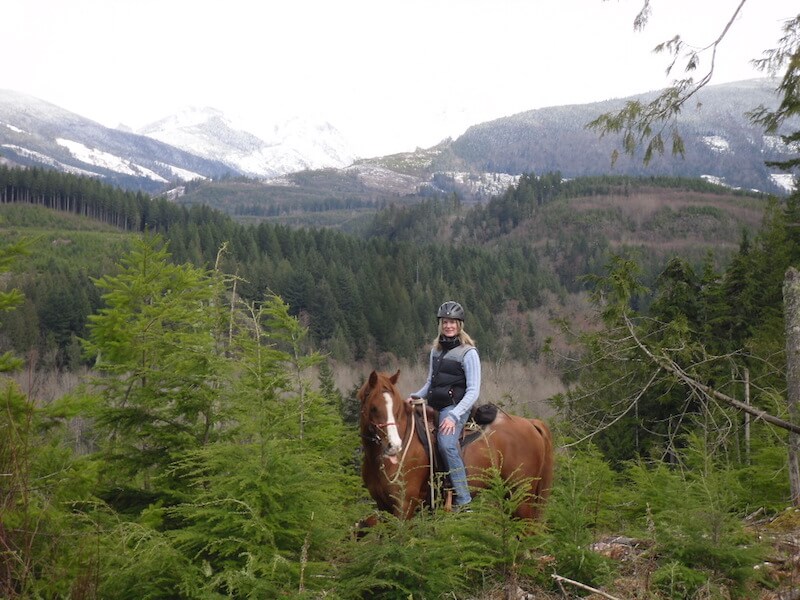Five Fundamental Skills of a Good Trail Horse
by Robert Eversole
We ask a lot of our trail mounts and most of what we’re asking isn’t what they’d be doing if they were the ones making the choices. This difference in desires is why trail rides can turn into a test of wills and skills. A leisurely ride quickly goes south if it’s frequently interrupted by spooks, refusals, or constant jigging. Sometimes simply traveling in a specific direction can be a challenge, let alone having our mounts willingly head through rivers and over bridges. What can we do to help our horses and mules perform better on the trail and bring the fun and enjoyment back into our rides?
Trail riding is every bit the equestrian sport that other riding disciplines are and require the same, if not more, effort in training. It utilizes aspects of every competitive sport, from dressage to western pleasure, and the trail rider competes in an “arena” with constantly changing footing, weather and seasons. We’ve all ridden with and envied riders whose mounts take every new encounter in stride. Chances are that rider took the time and effort to teach their horse to do a few things well long before they ventured onto the trail. Are you willing to put the same time and effort into your trail horse?
While I don’t claim to be a horse or mule trainer, here are a few ideas to train the fundamental skills required to have an enjoyable ride on the trail.
The Trailer Savvy Horse
Most trails aren’t at your stables so a trail horse has to willingly walk into and out of a trailer. Though many horses tend to be a bit leery of this dark box, given enough time and patience most learn to tolerate hauling. Loading problems may not be about getting into the trailer, per say, but rather about the relationship with your horse and your leadership skills. Or lack of. Making the trailer the happy spot is one way to break bad habits. I’ve lunged a recalcitrant horse only stopping to rest when near the trailer. Soon she loaded easily. Teaching your horse to load can take patience and much groundwork before it becomes a consistent loader but it’s worth the effort. A quiet and confident loader is the beginning of a pleasurable ride, for both of you.
The Willing Horse

A good trail horse should go wherever you ask: over obstacles, around trees, past mail boxes, and most certainly through water. If your mount has a tendency to navigate on its own, you’re going to have a serious problem at some point. Dealing with leadership issues at home is preferable to trying to deal with them on the trail. Remember that every time you’re in contact with your horse you’re training it.
Unwilling horses are a common problem for trail riders and this can be addressed at home through groundwork. Does your horse follow and listen to you in its comfort zone? If not why would he pay attention to your requests when out on the trail? When your horse considers you his herd leader at home and willingness is cultivated, you’ll be well on the way to a great ride on the trail.
The Calm Horse
Barking dogs, traffic, mail boxes, and wildlife are but a few situations where an over-reaction can turn into a very unpleasant situation in a hurry. Does your horse listen to you or does it look out for itself? Your horse’s reaction should be to stop, not bolt, and to wait for your cue.
Keeping your horse’s mind engaged and riding with a purpose can help calm a situation in times of stress. Are you an engaged rider, or a passive passenger? If your horse is listening to you it won’t be as inclined to worry about someone else’s problem. We all want an easygoing horse who quickly recovers from surprises. If you don’t have that horse, it’s smart to spend the time required to build your current horse’s confidence. Ideas to desensitize the horse and expose him to new stimuli in a controlled setting include trail challenge obstacles and group play days. A common example of something scary for horses is a hiker with a backpack. The training remedy could be as easy as wearing a backpack every time you feed.
The Agile Horse
Your horse and mule has four feet and should pay attention to where he is placing them. When you’re riding along an unstable trail, across loose rock, or any of a number of other situations, a sure footed beast can be a real lifesaver. Many us have been in situations where we have been very thankful that our mount knew exactly where each hoof was and where to place it next.
If your trail horse has a tendency to trip or seems unsteady at times, you can help him to pay attention to it’s feet working over cavaletti poles, obstacles and as much uneven ground as you can find. This will transfer to better attention on the trail.
The Independent Horse
If your horse feels it must trot if others trot, calls out to others, or refuses to leave the safety of the group you have a leadership problem. A herd bound horse wants to stay glued to the tail of the horse in front of him or explodes if separated from the group. This horse is no fun and can be dangerous because its trust is in the other horses rather than the rider.
This insecurity can be overcome by gradually lengthening the distance between yourself and other riders, and keeping your mount’s attention focused on you. Slowly expanding the herd bound horse’s zone of comfort around a familiar area will help him gain confidence and adjust more quickly to new environments. By spending the time and effort to develop your horse’s trust and confidence in your leadership you are building the bond that all horse people dream of.
Working on these fundamentals of trail horse training—with an experienced instructor if need be—will help you discover the good trail horse you might already own.
Published September 2013 Issue

Robert Eversole, ”the trail meister,” owns www.TrailMeister.com, the largest database of horse riding and camping areas in the U.S. with free trail and trailhead information, trail maps, and much more to help horse enthusiasts experience the joys of trail riding. Robert is a registered riding instructor with PATH International, a mounted search and rescue team member, and a U.S. Marine who has served on the board of the Backcountry Horsemen of Washington (BCHW). He is enjoying his new career helping fellow trail riders stay found and safe on the trail. When not on the trail, The Trail Meister resides near Spokane, WA and teaches land navigation to a wide variety of outdoor groups across the nation. For North America’s largest horse trail and camping directory, trail tips, and more, visit www.TrailMeister.com.






